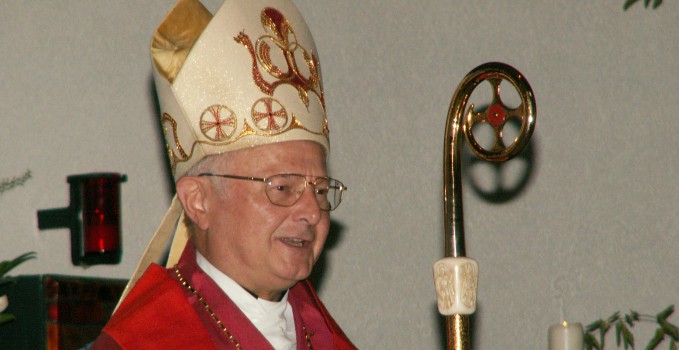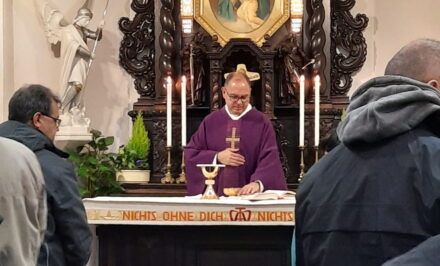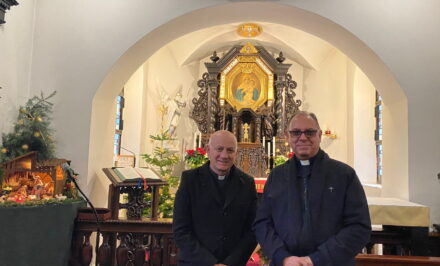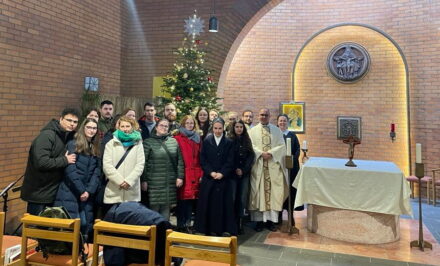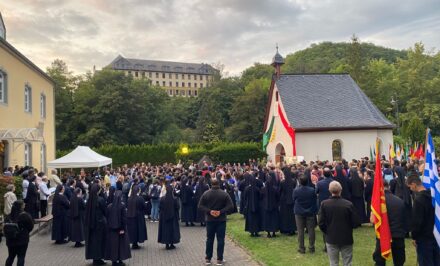ORIGINAL SHRINE/GERMANY from Maria Fischer •
“Schoenstatt, Vallendar on the Rhine, which celebrated its centenary last year, is the centre of a worldwide spiritual movement. Its focal point is a little chapel in the valley where Mary is honoured as “Thrice Admirable Mother”. The picture of grace, which arrived in Schoenstatt from Freiburg a hundred years ago, is well known worldwide, as the members of the cathedral choir experienced last year when they visited South America”. These were the words of the invitation addressed to the members of the Freiburg Cathedral Choir and their friends announcing a pilgrimage. During the trip mentioned above the Cathedral Choir sang, among other venues, at the centenary celebrations of the Schoenstatt Movement in Buenos Aires in the Teatro Colón, the most famous theatre in the city – an experience that moved them and filled them with enthusiasm. Spiritually accompanied by Archbishop Emeritus Robert Zollitsch DD, the choir made a pilgrimage last weekend to Schoenstatt and Kevelaer.
The press release of Freiburg Cathedral Music – Cathedral School, Freiburg, on 1 October 2015, stated, “The hospitality in Haus Marienau and a welcome by Fr Egon M. Zillekens, Rector, made for a warm arrival at the centre of Schoenstatt. The witty hint: All important things here begin with K … determined the further course of the evening. The kitchen offered a happy supper, we took part in an evening service in the chapel (Kapelle), not without a small musical contribution, and in the snug (Klause) the evening came to an end, but not too quickly. Fr Zillekens came to us later in the snug to check if everything was in order, and then after some hesitation allowed himself to be moved to join us. He spoke impressively and in a very lively way about his life as a pastor.”
In his sermon in the Pilgrims’ Church in Schoenstatt, Archbishop Zollitsch described Mary as the “Woman setting Out”, a woman going out in the spirit of Evangelii Gaudium. “As mother she is not the distant observer and world-estranged icon of glory. As mother she is turned towards and devoted to each of her children with tender and burning love. As at Cana, she is the friend, as Pope Francis wrote, “who is ever concerned that wine is not lacking in our lives. She is the woman whose heart was pierced by a sword and who understands all our pain.” (EG 286) She reaches out her hand towards us and invites us to take her hand, so that led by her and under her protection we may walk the pilgrim path of our faith, and also reach the goal God has promised us, and where she awaits us, in order to take her children into her arms.”
This, according to Zollitsch, has been the experience of pilgrims who have come to Schoenstatt for over a hundred years. “That is a special characteristic of the place of pilgrimage at Schoenstatt. Mary is not only our great example and comforting and understanding mother. She is, as Pope Francis never ceases to stress, the missionary, the active woman, who also sets out today and acts – for the Church and each individual person.”
Sermon of Archbishop Emeritus Robert Zollitsch DD during the pilgrimage of the Cathedral Choir to Schoenstatt on 26 September 2015
Mary, the Woman Setting Out
The first thing Mary did after she heard that she was to become the Mother of the Son of God, was – as we heard in the Gospel – to set out. She set out on the road over the mountains to her cousin Elizabeth, in order to bring the Redeemer to the people even before he was born.
I.
- She had experienced God breaking into her life, her middle class and quiet life in Nazareth. Through the message of the angel, through her task to serve God in a unique way as the Handmaid of the Lord, her life suddenly changed radically. She didn’t hesitate to give a clear answer, “Yes, I am the handmaid of the Lord, let what you have said be done to me!” God acted; Mary said Yes. She didn’t wait to see what would happen. She didn’t remain in idyllic Nazareth. No, she took the initiative. She had heard that her cousin Elizabeth was already in her sixth month despite her advanced age. She set out and hastened over the mountains to Elizabeth. She bore God’s great mystery in herself, a message that was meant to reach all people.
She brought the new and tremendous reality that had started in her womb to the people waiting to receive it. She experienced how Elizabeth and John recognised this new reality: John leapt for joy in his mother’s womb and Elizabeth called Mary blessed. - When God breaks into our world, into our lives, it has this consequence. Mary’s life changed in a moment. She took a stand to the new situation; she adjusted herself completely to the new reality, without knowing what it would mean for her and her life. Only one person and one thing would in future determine her life: the Son of God and accompanying him. It is the content and goal of her path through life; it determined every phase and every step.
- Indeed, Mary’s path through life became a path with her Son and for him. There was that journey of the heavily pregnant woman of Nazareth to Bethlehem in order to be enrolled in the tax lists, and the birth of her Son in a humble stable. There was that long journey as the fled from Herod to Egypt. Together with her Son she shared rejection, flight, homelessness, foreign parts. She experienced the enthusiasm of the people for her Son following his powerful appearance and his powerful deeds. However, she also experienced his rejection and the hatred he had to confront. Together with her relations she feared for his life and set off to fetch him home. She went with her Son even when she didn’t understand him, and where everything was very dark. She stood by him under the cross. Her path through life was a path accompanying her Son, for him and for us: Setting out into a completely new dimension into which God led her, he alone.
II.
- What was the reason, what were the safeguards Mary had that enabled her to walk this path? Well, there were the words of the angel, the experience of Christmas, life with her Son – although in the very modest and hidden life in Nazareth. There were also the anxious questions of rejection and flight, the anxious search for her lost son, for the twelve-year-old, and his dismissive words to his parents. There was the incredible and agonizing darkness on Golgotha. Mary’s faith was challenged – her faith in God’s promise. She was the first to hear the message of the Redeemer, Jesus Christ; the first whose faith was demanded; the first who set off with him, who followed him: the first believer of the New Covenant, the first disciple of her Son. She is the pioneer of the new reality, pioneer of the “new way”, the way of redemption, the pioneer of our salvation, a woman who was constantly setting out.
- It was for this that God had called and chosen this young woman, the little handmaid of Nazareth. If was for this that he had prepared her. In view of this almost incomprehensible task, God had, as our Catholic faith tells us, preserved her from every sin and kept her away from the intertwining of humankind with sin. So he also took her, the first of the redeemed and the first believer of the New Covenant, and also the first who was perfected, with body and soul into his glory. That is how greatly God acts with regard to the Mother of his Son. That is how greatly God thinks of humankind.
- Yes, that is how God dealt with his little handmaid for the sake of his Son, but also for our sakes. For Jesus has given his Mother to us to be the Mother of all of us. In his Apostolic Exhortation “The Joy of the Gospel”, Pope France wrote, “On the cross … at that crucial moment, before fully accomplishing the work which his Father had entrusted to him, Jesus said to Mary: ‘Woman, here is your son’. Then he said to his beloved friend: ‘Here is your mother’ (Jn 19:26-27). … Jesus left us his mother to be our mother. Only after doing so did Jesus know that ‘all was now finished’ (Jn 19:28). At the foot of the cross, at the supreme hour of the new creation, Christ led us to Mary. He brought us to her because he did not want us to journey without a mother. … Mary, who brought him (Jesus) into the world with great faith, also accompanies ‘the rest of her offspring, those who keep the commandments of God and bear testimony to Jesus’ (Rev 12:17).” (EG 285)
III.
- As mother she is not the distant observer and world-estranged icon of glory. As mother she is turned towards and devoted to each of her children with tender and burning love. As at Cana, she is the friend, as Pope Francis wrote, “who is ever concerned that wine is not lacking in our lives. She is the woman whose heart was pierced by a sword and who understands all our pain.” (EG 286) She reaches out her hand towards us and invites us to take her hand, so that led by her and under her protection we may walk the pilgrim path of our faith, and also reach the goal God has promised us, and where she awaits us, in order to take her children into her arms.
- Such is the mother God has given to us. She is there for us, she understands us and is always ready to help us. That is without doubt the experience of many pilgrims who have come here for over a hundred years to the Mother of God. Like the disciples who assembled around Mary in the Upper Room after Jesus had ascended to heaven, so we are also with her today and place our trust in the Blessed Mother, the Mother of the Church. We know that we are encouraged and supported by the many and varied experiences of the pilgrims before us, and turn to her with the invocations of the Litany of Loreto, to the “Comforter of the afflicted” and the “Help of Christians”. She reaches out to us as the “Virgin who is powerful to help”, and stands before us as the “Tower of David” in whom we find protection; as the “Gate of heaven” who again and again invites us to turn to God and leads us to him.
- In his fundamental Apostolic Exhortation “The Joy of the Gospel” Pope Francis takes a further decisive step. His concern is with a Church that sets out after the example of Mary and under her direction. His concern is with a new challenge, the challenge of “going forth” (EG 20), that is, “a new chapter of evangelization marked by this joy, while pointing out new paths for the Church’s journey in the years to come” (EG 1). What matters is a “new missionary ‘going forth’” (EG 20), a Church that is wholly and completely missionary. And “the Mother of this missionary Church”, according to the Pope, is ‘Mary, … for without her we could never truly understand the spirit of the new evangelization” (EG 284). “With the Holy Spirit, Mary is always present in the midst of the people. She joined the disciples in praying for the coming of the Holy Spirit (Acts 1,14), and thus made possible the missionary outburst which took place at Pentecost” (EG 284).
The missionary activity of the Church has a Marian style, Pope Francis said. “Whenever we look to Mary, we come to believe once again in the revolutionary nature of love and tenderness. In her we see that humility and tenderness are virtues not of the weak, but of the strong” (EG 288).
The Marian way of evangelizing means being with the people, knowing what moves them. It means accepting them in the circumstances and concerns of their lives, and walking with them and in their shoes along the path of their faith, their struggle. A Marian way of evangelizing means being an inviting Church. Where Mary is at work, a community comes into existence, the Church grows. A motherly Church that shelters and offers a home. A fraternal Church borne by love and solidarity. A Marian Church that day by day takes its bearings from God in order to bring people to Christ, and let them experience his welcoming and forgiving mercy.
That is a special characteristic of the place of pilgrimage at Schoenstatt. Mary is not only our great example and comforting and understanding mother. She is, as Pope Francis never ceases to stress, the missionary, the active woman, who also sets out today and acts – for the Church and each individual person. She reaches out her hand to us, in order to form us into disciples of Christ, and to accompany us actively on our pilgrim way. She wants to help us to fill with life the covenant God entered into with us at our baptism, and that each of us has made with him. In order to help us to do so, she invites us to entrust ourselves to her, to take her outstretched hand, and enter into a covenant with her, a covenant of love with her, because as a loving Mother she has only one thing in mind – to unite us, her children, more deeply with God and to lead us to him.
At the same time she is not only concerned about our own way to God and our way with him. As the missionary woman she guides us to bear witness to the Gospel, to share our faith with others, and in this way to pass on the message of life. The members and friends of our Freiburg Cathedral Choir experienced something of this during our concert tour of South America – in Argentina, Uruguay and Chile. It is strange and thought-provoking that a picture of Mary, which Professor Huggle bought for 23 Marks over a hundred years ago in a shop selling religious articles in the Herrenstrasse in Freiburg, and brought to Schoenstatt, became a picture of grace, and today, according to Google, is one of the seven best-known pictures of Mary in the world. Even more, in this picture Mary has set out to wander through the world.
The Brazilian deacon, Joao Luiz Pozzobon, got the idea to carry Mary in this picture to the people. For thirty-five years he carried it on his shoulder as he walked from place to place. This gave rise to an unexpected and amazing chain reaction: Today Mary, as the Pilgrim Mother, in on the way to the people in 200 000 pilgrim pictures in almost a hundred countries on every continent.
She also holds out her hand to us and invites us to join her. She encourages us to set out, as she did, and to live our lives trusting in her and led by her hand – with our Holy Father’s request in our hearts: “Virgin and Mother, give us a holy courage to seek new paths.” (EG 288). We may trust that she will go ahead of us. Amen.


